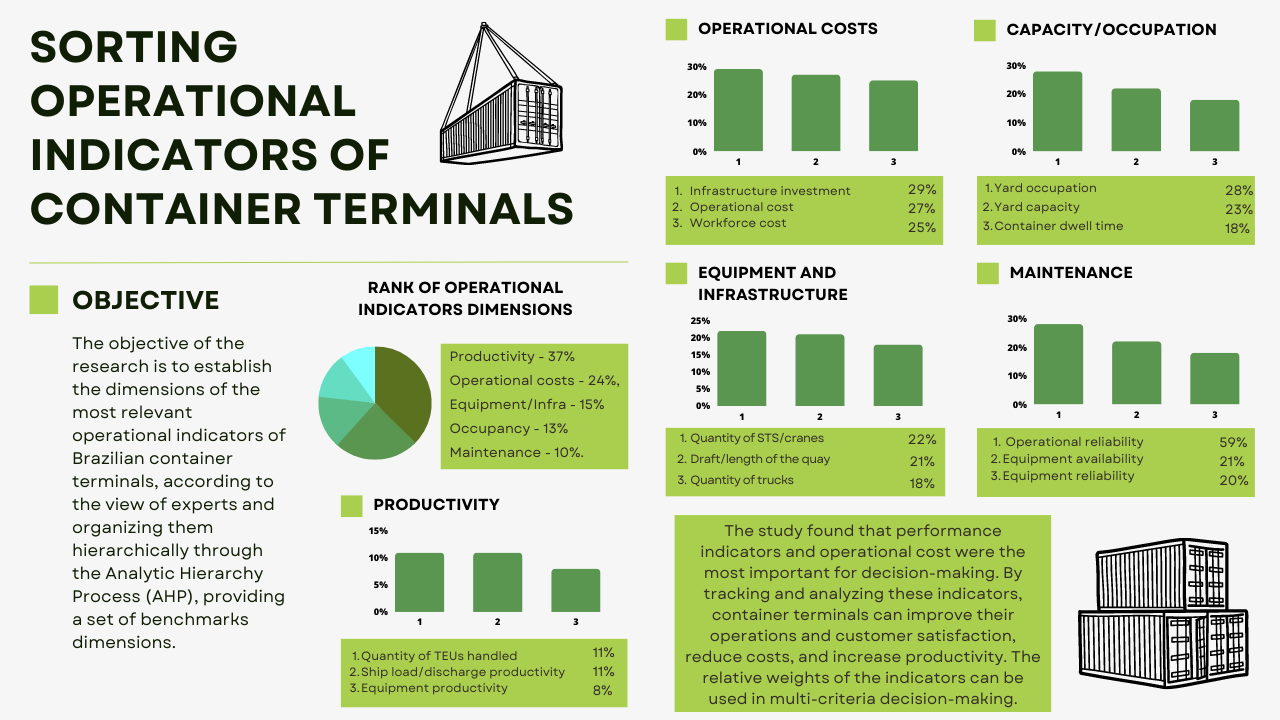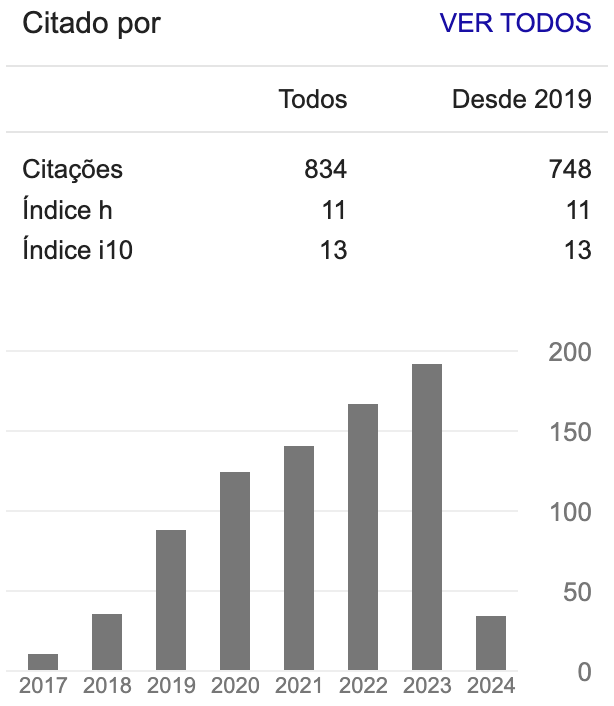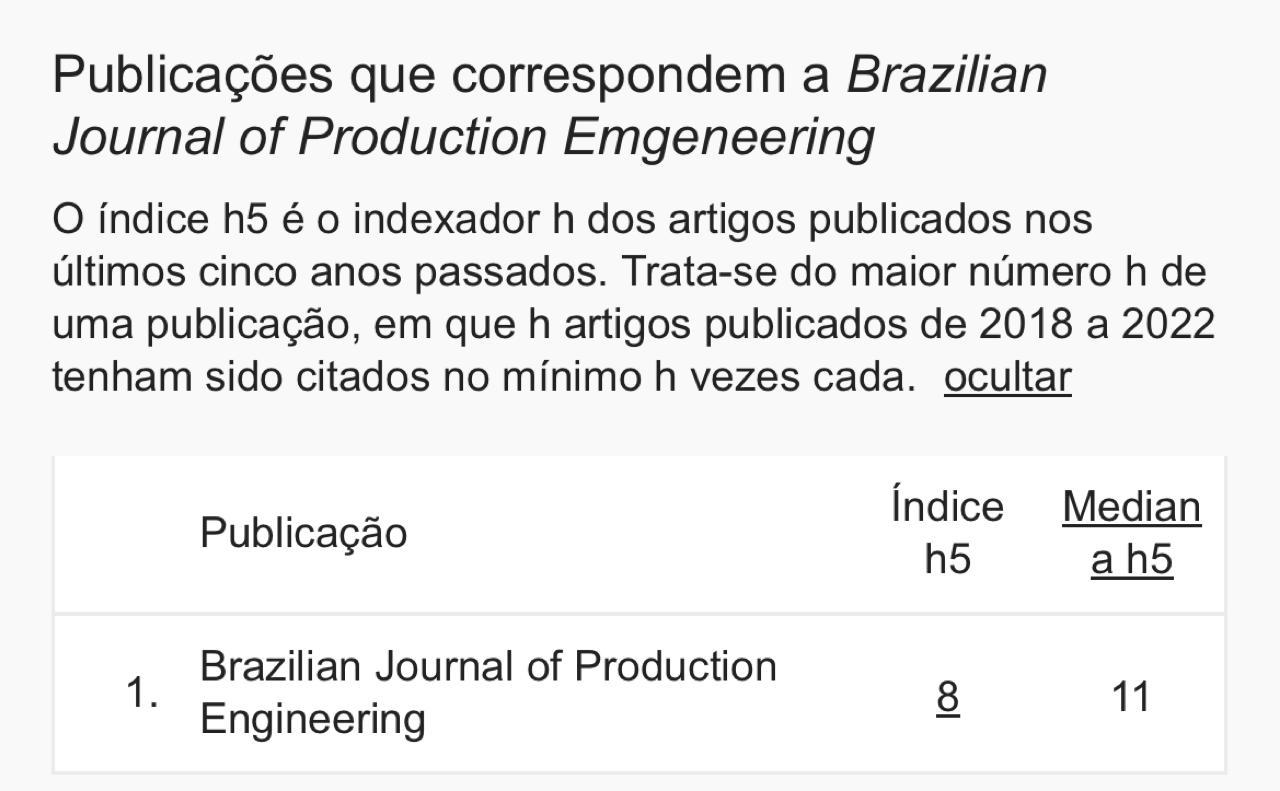Ordenando indicadores operacionais de terminais contêiner
DOI:
https://doi.org/10.47456/bjpe.v9i2.40525Keywords:
AHP, porto, indicadores operacionaisAbstract
Os portos são conhecidos por desempenharem um papel importante em sistemas de transporte multimodal e cadeias de suprimentos internacionais, exigindo eficiência operacional para fornecer valor aos clientes. A fim de garantir um serviço de alto nível, gerenciar uma organização com base em indicadores de desempenho é essencial para direcionar as operações ao plano estratégico. Terminais de contêineres estão inseridos nesse contexto, onde o esforço de gestão e os recursos financeiros devem ser equilibrados para alcançar a melhor utilidade de todo o sistema. Com isso em mente, esta pesquisa tem como objetivo estabelecer as dimensões dos indicadores operacionais mais relevantes dos terminais de contêineres brasileiros, aplicando o método multicritério Analytic Hierarchy Process (AHP), fornecendo um conjunto de indicadores como referência para os tomadores de decisão. Para alcançar esse objetivo, realizamos uma revisão sistemática nas bases de dados Scopus, identificando 38 indicadores operacionais que foram comparados em pares por gerentes que representam 7 terminais de contêineres brasileiros, responsáveis pelo movimentar 71% do volume total de contêineres do Brasil. Esta pesquisa tem contribuições práticas e teóricas, classificando os indicadores operacionais para ajudar os tomadores de decisão a gerenciar terminais de contêineres em direção à sua estratégia.
Downloads
References
Agência Nacional de Transportes Aquaviários. (2022). Estatísticas. Recuperado de https://web3.antaq.gov.br/ea/smartphone/pages/movContainer/movContainer.html
Agência Nacional dos Transportes Ferroviários. (2019). The Brazilian Rail Freight Sector. Recuperado de https://www.antf.org.br/informacoes-gerais/
Al-Eraqi, A., Mustafa, A., & Khader, A. (2010). An extended DEA windows analysis: Middle East and East African seaports. Journal of Economic Studies, 37(2), 208-218. https://doi.org/10.1108/01443581011043591 DOI: https://doi.org/10.1108/01443581011043591
Bierwirth, C. & Meisel, F. (2010). A survey of berth allocation and quay crane scheduling problems in container terminals. European Journal of Operational Research, 202(3), 615-627. https://doi.org/10.1016/j.ejor.2009.05.031 DOI: https://doi.org/10.1016/j.ejor.2009.05.031
Božičević, J., Lovrić, I., Bartulović, D., Steiner, S., Roso, V., & Škrinjar, J. (2021). Determining Optimal Dry Port Location for Seaport Rijeka Using AHP Decision-Making Methodology. Sustainability, 13, 6471. https://doi.org/10.3390/su13116471 DOI: https://doi.org/10.3390/su13116471
Caggiani, L., Iannucci, G., Ottomanelli, M., Tangari, L., & Sassanelli, D. (2012). A fuzzy data meta training system for ranking hub container terminals. European Transport, 51(4), 1-16.
Cartenì, A. & Luca, S. (2012). Tactical and strategic planning for a container terminal: Modelling issues within a discrete event simulation approach. Simulation Modelling Practice and Theory, 21, 123-145. https://doi.org/10.1016/j.simpat.2011.10.005 DOI: https://doi.org/10.1016/j.simpat.2011.10.005
Cruz, M., Ferreira, J., & Azevedo, S. (2013). Key factors of seaport competitiveness based on the stakeholder perspective: An Analytic Hierarchy Process (AHP) model. Maritime Economics & Logistics, 15, 416-443. https://doi.org/10.1057/mel.2013.14 DOI: https://doi.org/10.1057/mel.2013.14
Almeida, A., de. (2013). Processo de decisão nas organizações: construindo modelos de decisão multicritério. São Paulo: Atlas.
Drucker, P. (1954). The practice of management. New York: Harper & Row.
Fazi, S. & Roodbergen, K. (2018). Effects of demurrage and detention regimes on dry-port-based inland container transport. Transp. Res. Part C, 89, 1-18. https://doi.org/10.1016/j.trc.2018.01.012 DOI: https://doi.org/10.1016/j.trc.2018.01.012
Felicio, J., Caldeirinha, V., & Dionísio, A. (2014). The effect of port and container terminal characteristics on terminal performance. Maritime Economics & Transportation, 17, 493-514. https://doi.org/10.1057/mel.2014.33 DOI: https://doi.org/10.1057/mel.2014.33
Feng, M., Mangan, J., & Lalwani, C. (2012). Comparing port performance: Western European versus Eastern Asian ports. International Journal of Physical Distribution & Logistics Management, 42(5), 490-512. https://doi.org/10.1108/09600031211246537 DOI: https://doi.org/10.1108/09600031211246537
Gonçalves, W., Rocha, A., Zatta, F., & Santos, D. (2021). Analytic hierarchy process (AHP) e a definição de atributos para apoio a tomada de decisão: uma análise bibliométrica. Brazilian Journal od Production Engineering, 7(5), 103-118. https://doi.org/10.47456/bjpe.v7i5.36744 DOI: https://doi.org/10.47456/bjpe.v7i5.36744
Ha, M. & Yang, Z. (2017). Comparative analysis of port performance indicators: Independency and interdependency. Transportation Research Part A, 103,264-278. https://doi.org/10.1016/j.tra.2017.06.013 DOI: https://doi.org/10.1016/j.tra.2017.06.013
Ha, M., Yang, Z., Notteboom, T., Ng, A., & Heo, M. (2017). Revisiting port performance measurement: A hybrid multi-stakeholder framework for the modelling of port performance indicators. Transp. Res. Part E, 103, 1–16. https://doi.org/10.1016/j.tre.2017.04.008 DOI: https://doi.org/10.1016/j.tre.2017.04.008
Haralambides, H. (2019). Gigantism in Container Shipping, Ports and Global Logistics: A Time-Lapse into the Future. Maritime Economics and Logistics, 21, 1-60. https://doi.org/10.1057/s41278-018-00116-0 DOI: https://doi.org/10.1057/s41278-018-00116-0
Hauser, J. & Katz, G. (1998). Metrics: You Are What You Measure! European Management Journal, 16(5), 517-528. https://doi.org/10.1016/S0263-2373(98)00029-2 DOI: https://doi.org/10.1016/S0263-2373(98)00029-2
Huang, W., Wang, J., Kuo, T., & Wu, C. (2010). A Research on the Improvement Strategy on the Operation performance of Container Terminal. Journal of the Eastern Asia Society for Transportation Studies, 9, 2256-2271.
Instituto Brasileiro de Geografia e Estatística. (2020). Projections of the population in Brazil. Recuperado de https://www.ibge.gov.br/apps/populacao/projecao/
Jamain, R., Zakaria, R., & Satar, N. (2023). Asian port performance dimensions and analysis: a systematic literature review. International Journal of Professional Business Review, 8, 1-37. https://doi.org/10.26668/businessreview/2023.v8i1.1165 DOI: https://doi.org/10.26668/businessreview/2023.v8i1.1165
Jiang, J., Lee, L., Chew, E., & Gan, C. (2015). Port connectivity study: An analysis framework from container liner shipping network perspective. Transportation Research Part E, 73, 47-64. https://doi.org/10.1016/j.tre.2014.10.012 DOI: https://doi.org/10.1016/j.tre.2014.10.012
Júnior, R. (2008). Hierarquização dos Indicadores de Desempenho da Qualidade Aplicada aos Terminais Portuários de Movimentação de Contêineres (Dissertação de Mestrado). Instituto Militar de Engenharia, Rio de Janeiro, Brasil.
Kaplan, R. & Norton, D. (1992). The Balanced Scorecard: Measures that drive performance. Harvard Business Review, 5(3), 71-79.
Keeney, R. L. (1992). Value-focused thinking: A path to creative decision making. Cambridge: Harvard University Press.
Khaslavskaya, A. & Roso, V. (2020). Dry ports: research outcomes, trends, and future implications. Maritime Economics and Logistics, 22, 265-292. https://doi.org/10.1057/s41278-020-00152-9 DOI: https://doi.org/10.1057/s41278-020-00152-9
Kim, B., Kim, G., & Kang, M. (2022). Study on Comparing the Performance of Fully Automated Container Terminals during the COVID-19 Pandemic. Sustainability, 14, 9415. https://doi.org/ 10.3390/su14159415 DOI: https://doi.org/10.3390/su14159415
Lam, J. & Song, D. (2013). Seaport network performance measurement in the context of global freight supply chains. Polish Maritime Research, 20, 47-54. https://doi.org/10.2478/pomr-2013-0026 DOI: https://doi.org/10.2478/pomr-2013-0026
Lamii, N., Bentaleb, F., Fri, M., Mabrouki, C., & Semma, E. (2022). Use of DELPHI-AHP Method to Identify and Analyze Risks in Seaport Dry Port System. Transactions on Maritime Science, 11, 185-206. https://doi.org/10.7225/toms.v11.n01.w12 DOI: https://doi.org/10.7225/toms.v11.n01.w12
Largen, P., & Sharypova, K. (2013). Intermodal connectivity as a port performance indicator. Research in Transportation Business & Management, 8, 97-102. https://doi.org/10.1016/j.rtbm.2013.06.003 DOI: https://doi.org/10.1016/j.rtbm.2013.06.003
Lee, B. & Kim, K. (2013). Optimizing the yard layout in container terminals. OR Spectrum, 35(2), 363-398. https://doi.org/10.1007/s00291-012-0298-z DOI: https://doi.org/10.1007/s00291-012-0298-z
Mahtani, U. & Garg, C. (2018). An analysis of key factors of financial distress in airline companies in India using fuzzy AHP framework. Transportation Research Part A, 117(C), 87-102. https://doi.org/10.1016/j.tra.2018.08.016 DOI: https://doi.org/10.1016/j.tra.2018.08.016
Mauboussin, M. (2012). The True Measures of Success. Most Companies Use The Wrong Performance Metrics. Don’t Be One Of Them. Harvard Business Review, 90(10), 4-10.
Ministério do Desenvolvimento, Indústria, Comércio e Serviços. (2021). Import and export general data. Recuperado de http://comexstat.mdic.gov.br/pt/geral
Moya, J. & Valero, M. (2016). Port choice in container market: a literature review. Transport Reviews, 37, 300-321. https://doi.org/10.1080/01441647.2016.1231233 DOI: https://doi.org/10.1080/01441647.2016.1231233
Munim, Z. & Schramm, H. (2018). The impacts of port infrastructure and logistics performance on economic growth: the mediating role of seaborne trade. Journal of Shipping and Trade, 3, 1-16. https://doi.org/10.1186/s41072-018-0027-0 DOI: https://doi.org/10.1186/s41072-018-0027-0
Niedritis, A., Niedrite, L., & Kozmina, N. (2011). Performance measurement framework with formal indicator definitions. Perspectives in Business Informatics Research, 90, 44-58. https://doi.org/10.1007/978-3-642-24511-4_4 DOI: https://doi.org/10.1007/978-3-642-24511-4_4
Nosal, K. & Solecka, K. (2014). Application of AHP Method for Multi-criteria Evaluation of Variants of the Integration of Urban Public Transport. Transportation Research Procedia, 3, 269-278. https://doi.org/10.1016/j.trpro.2014.10.006 DOI: https://doi.org/10.1016/j.trpro.2014.10.006
Pun, K. & Nurse, A. (2010). Adopting quality management principles to revitalise the facilities maintenance practices at a port: A study in Trinidad and Tobago. Asian Journal on Quality, 11(3), 197-209. https://doi.org/10.1108/15982681011093961 DOI: https://doi.org/10.1108/15982681011093961
Rashidi, H. & Tsang, E. (2013). Novel constraints satisfaction models for optimization problems in container terminals. Applied Mathematical Modelling, 37, 3601-3634. https://doi.org/10.1016/j.apm.2012.07.042 DOI: https://doi.org/10.1016/j.apm.2012.07.042
Rezaei, J. & Ortt, R. (2013). Supplier segmentation using fuzzy logic. Industrial Marketing Management, 42(4), 507-517. https://doi.org/10.1016/j.indmarman.2013.03.003 DOI: https://doi.org/10.1016/j.indmarman.2013.03.003
Rios, C. & Sousa, R. (2014). Cluster analysis of the competitiveness of container ports in Brazil. Transportation Research Part A, 69, 423-431. https://doi.org/10.1016/j.tra.2014.09.005 DOI: https://doi.org/10.1016/j.tra.2014.09.005
Rodrigues, T., Mota, C., Pinto, D., & Araújo, A. (2021). Identifying the factors engaged in customers’ choice to operate through dry port or seaport [Anais do International Joint Conference on Industrial Engineering and Operations Management]. IJCIEOM 2021, Rio de Janeiro, Brasil. DOI: https://doi.org/10.14488/IJCIEOM2020_FULL_0002_37430
Saaty, T. (1987). The Analytic Hierarchy Process: What it is and how it is used. Math Modelling, 9(3), 161-176. DOI: https://doi.org/10.1016/0270-0255(87)90473-8
Saaty, T. (1994). Fundamentals of Decision Making and Priority Theory with the Analytic Hierarchy Process. 1 ed. Pittsburgh: Hardcopy.
Saaty, T. (2012). Decision Making for Leaders: The Analytic Hierarchy Process for Decision in a Complex World. 3 ed. Pittsburgh: RWS Publication.
Saaty, T. & Alexander, J. (2013). Conflict Resolution: The Analytic Hierarchy Approach. Pittsburgh: RWS Publication.
Simoni, M., Schiavone, F., Risitano, M., Leone, D., & Chen, J. (2022). Group-Specific Business Process Improvements via a Port Community System: The Case of Rotterdam. Production Planning and Control, 33(4), 371-385. https://doi.org/10.1080/09537287.2020.1824029 DOI: https://doi.org/10.1080/09537287.2020.1824029
Subramian, N. & Ramanathan, R. (2012). A review of applications of Analytic Hierarchy Process in operations management. Int. J. Production Economics, 138, 215-241. https://doi.org/10.1016/j.ijpe.2012.03.036 DOI: https://doi.org/10.1016/j.ijpe.2012.03.036
Talley, M. & Ng, M. (2013). Maritime transport chain choice by carriers, port and shippers. Int. J. Production Economics, 142, 311-316. https://doi.org/10.1016/j.ijpe.2012.11.013 DOI: https://doi.org/10.1016/j.ijpe.2012.11.013
Tapia, R., Zárate, C., Esteban, A., Vieira, G., & Senna, L. (2014). Proposición y Evaluación de Indicadores de Movimiento de Carga para el puerto de Mar Del Plata. Espacios, 35(11), 9-21.
Tran, N., Haasis, H., & Buer, T. (2017). Container Shipping Route Design Incorporating the Costs of Shipping, Inland/Feeder Transport, Inventory and CO2 Emission. Maritime Economics and Logistics, 19(4), 667–694. https://doi.org/10.1057/mel.2016.11 DOI: https://doi.org/10.1057/mel.2016.11
Tranfield, D., Deyer, D., & Smart, P. (2003). Towards a Methodology for Developing Evidence-Informed Management Knowledge by Means of Systematic Review. British Journal of Management, 14(3), 207-222. https://doi.org/10.1111/1467-8551.00375 DOI: https://doi.org/10.1111/1467-8551.00375
United Nations Conference on Trade and Development. (2019). Review of maritime transport. Recuperado de https://unctad.org/en/Pages/Publications/Review-of-Maritime-Transport-(Series).aspx
Vaidya, O. & Kumar, S. (2006). Analytic hierarchy process: An overview of applications. European Journal of Operational Research, 169, 1-29. https://doi.org/10.1016/j.ejor.2004.04.028 DOI: https://doi.org/10.1016/j.ejor.2004.04.028
Yeo, G., Roe, M., & Dinwoodie, J. (2011). Measuring the competitiveness of container ports: logisticians’ perspectives. European Journal of Marketing, 45(3), 455-470. https://doi.org/10.1108/03090561111107276 DOI: https://doi.org/10.1108/03090561111107276

Downloads
Published
How to Cite
Issue
Section
License
Copyright (c) 2023 Brazilian Journal of Production Engineering

This work is licensed under a Creative Commons Attribution-NonCommercial-ShareAlike 4.0 International License.
Atribuição-NãoComercial-CompartilhaIgual
CC BY-NC-SA
This license lets others remix, adapt, and build upon your work non-commercially, as long as they credit you and license their new creations under the identical terms.






































































